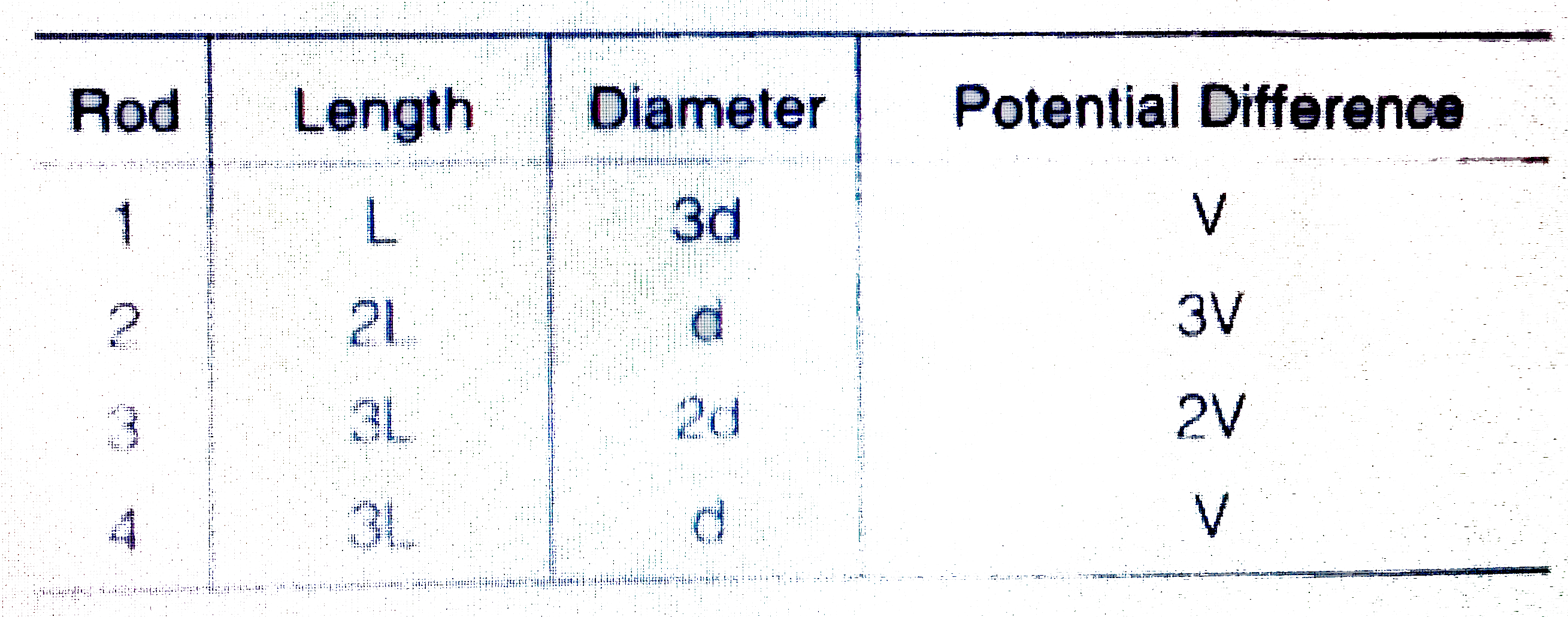The following table gives the lengths of four aluminium rods of uniform cross-section their diameters and potential difference maintained across the opposite ends of the rods. All the four rods are maintained at the same temperature.

Now answer the following questions :
(a) Which rod has maximum resistance ? (b) Which rod carries the maximum current ? (c) In which rod is the drift speed of electrons maximum ? (d) In which rod does the dissipation of electric energy take place at a maximum rate ? Give reason for each of your answer.
(a) ∵R=ρLA=4ρLπD2⇒R∝LD2
∴R1:R2:R3:R4=L9D2:2LD2:3L4D2:3LD2=19:2:34:3
It shows that R4 is maximum
(b) Current I=VR
∴I1:I2:I3:I4=VR1:3VR2:2VR3:VR4=V.9D2L:3V.D22L:2V.4D23L:V.D23L
=9VD2L:3VD22L:8VD23L:VD23L=9:32:83:13
It shows that I1 is maximum
( c) Drift speed vd∝1A or vd∝VL
∴(vd)1:(vd)2:(vd)3:(vd)4=VL:3V2L:2V3L:V3L=1:32:23:13
It shows that (vd)2 is maximum
(d) Rate of electrical energy dissipated P=V2R=πV2D24ρL=P∝V2D2L
∴P1:P2:P3:P4=V2(3D)2L:(3V)2.D22L:(2V)2.(2D)23L:V2D23L=9:92:163:13
It shows that P1 is maximum .
Topper's Solved these Questions
- CURRENT ELECTRICITY BOOK - U-LIKE SERIESCHAPTER - CURRENT ELECTRICITY EXERCISE - MULTIPLE CHOICE QUESTIONS
35 Videos
- CURRENT ELECTRICITY BOOK - U-LIKE SERIESCHAPTER - CURRENT ELECTRICITY EXERCISE - FILL IN THE BLANKS
18 Videos
- CURRENT ELECTRICITY BOOK - U-LIKE SERIESCHAPTER - CURRENT ELECTRICITY EXERCISE - ADDITIONAL EXERCISES
14 Videos
- CBSE SAMPLE QUESTION PAPER 2019-20 (SOLVED)BOOK - U-LIKE SERIESCHAPTER - CBSE SAMPLE QUESTION PAPER 2019-20 (SOLVED)EXERCISE - SECTION D
6 Videos
- DUAL NATURE OF RADIATION AND MATTERBOOK - U-LIKE SERIESCHAPTER - DUAL NATURE OF RADIATION AND MATTEREXERCISE - SELF ASSESSMENT TEST SECTION-C (VERY SHORT ANSWER QUESTIONS)
3 Videos
Similar Questions
Which of the following characteristics of electrons determines the current in a conductor ?
View SolutionElectric current density is a_______ quantity whereas electric current is a ______ quantity.
View Solution(a) Six lead-acid type of secondary cells each of emf 2.0 V and internal resistance 0.015 Ω are joined in series to provide a supply to a resistance of 8.5 Ω. What are the current drawn from the supply and its terminal voltage ?
(b) A secondary cell after long use has an emf of 1.9 V and a large internal resistance of 380 Ω . What maximum current can be drawn from the cell ? Could the cell drive the starting motor of a car?
View Solution(a) Using Gauss's law, derive expression for intensity of electric field at any point near the infinitely long straight uniformly charged wire.
(b) The electric field components in the following figure are Ex=αx,Ey=0,Ez=0, in which α=400N/Cm. Calculate (i) the electric flux through the cube, and (ii) the charge within the cube assume that a=0.1m.

View SolutionDefine the term 'work function' of a metal. The threshold frequency of a metal is f0. When the light of frequency 2f0 is incident on the metal plane, the maximum velocity of electrons is v1. When the frequency of the incident is increased to 5f0, the maximum velocity of electrons emitted is v2. find the ratio of v1 to v2.
View SolutionA semicircular rods is joined at its end to a straight rod of the same material and the same cross-sectional area. The straight rod formss a diameter of the other rod. The junction are maintaine dat different temperature. Find the ratio of the heat transffered through a cross section of the straigh rod in a given time.
View SolutionTwo ends of rods of length L and radius R of the same material of kept at the same temperature. Which of the following rods conducts the maximum heat?
View SolutionTwo rods A and B of same length and cross-sectional area are connected in series and a temperature difference of 100^@C is maintained across the combination as shoen in Fig. If the thermal conductivity of the rod A is 3 k and that of rod B is k, Then i.Determine the thermal resistance of each rod. ii. determine the heat current flowing through each rod. iii. determine the heat current flowing through each rod. iv. plot the variation of temperature along the length of the rod.
View SolutionTwo rods of different materials having differnet lengths and same cross sectional areas are joined end to end in a straight line. The free ends of this compound rod are maintained at different temperatures The temperature gradient in each rod will be .
View Solutionthe following table gives the lengths of four copper rods at the temperature ,their diameters and the potential differences between their ends.


View SolutionFive rods of same material and same cross-section are joined as shown. Lengths of rods ab, ad and bc are l, 2l and 3l respectively. Ends a and c are maintained at temperatures 200∘C and 0∘C respectivelly.

For what length x of rod dc there will be no heat flow through rod bd ?
View SolutionTwo rods A and B of different materials but same cross section are joined as in figure. The free end of A is maintained at 100°C and the free end of B is maintained at 0°C. If l_2=2l_1,K_1=2K_2 and rods are thermally insulated from sides to prevent heat loses then the temperature theta of the junction of the two rods is
View SolutionThe ends of the two rods of different materials with their lengths, diameters of cross-section and thermal conductivities all in the ratio 1 : 2 are maintained at the same temperature difference. The rate of flow of heat in the shorter rod is 1cals^(-1) . What is the rate of flow of heat in the larger rod:
View SolutionThe two ends of a uniform rod of thermal conductivity k are maintained at different but constant temperatures. The temperature gradientat any point on the rod is (d theta)/(dl) (equal to the difference in temperature per unit length). The heat flow per unit time per unit cross-section of the rod is l then which of the following statements is/are correct:
View SolutionIs it possible to maintain a constant difference in the lengths of a brass rod and a steel rod, at all temperatures?
View Solution
